Engine Hyundai Terracan 2004 Owners Manual
[x] Cancel search | Manufacturer: HYUNDAI, Model Year: 2004, Model line: Terracan, Model: Hyundai Terracan 2004Pages: 361, PDF Size: 4.69 MB
Page 201 of 361

CONTROLS AND EQUIPMENT1- 1
ZB000A1-A
1. CONTROLS AND
EQUIPMENT neck. However, care must be exercised when refuelling the vehicle tank from jerry cans or bymeans of a funnel that the fuel being used isunleaded.
The use of leaded fuel in this vehicle will result
in irreversible pollution of the catalyst element.Such pollution will prevent correct operation ofthe catalyst and give rise to increased operat-ing temperatures leading to the catalyst ele-ment melting and restricting the exhaust flowalong with an increase in exhaust emissionlevels.
CAUTION: The vehicle warranty will not extend to dam-
age arising from the use of incorrect fuels.
Unleaded fuel with a Research Octane Number
(RON) of 91 or higher must be used in this vehicle. To prevent accidental filling of the fuel tank with
leaded fuel, a small diameter filler neck alongwith a restrictor flap are fitted to ensure that onlyunleaded fuel pump nozzles may enter the filler
B010A02HP.DAG
UNLEADED FUEL ONLY
B010A01HP-EAT FUEL RECOMMENDATIONS PETROL ENGINES THIS VEHICLE MUST ONLY BE OPERATED
WITH UNLEADED FUEL.
SERIOUS DAMAGE WILL RESULT FROM
THE USE OF LEADED FUEL.
DIESEL ENGINESDiesel fuel of 52 to 54 cetane is the correct
rating to use in your Hyundai Terracan. If two types of diesel fuel are available, use summeror winter fuel properly according to the followingtemperature conditions.
o Above 23°F (-5°C) ... Summer type diesel fuel.
o Below 23°F (-5°C) ... Winter type diesel fuel.
Watch the fuel level in the tank very carefully :
If the engine stops due to fuel failure, the circuits must be completely purged to permitrestarting. CAUTION: Do not let any petrol or water enter the tank.
If this happens, the tank should be com- pletely drained and the fuel lines should allbe cleaned out. This will stop the fuel pumpfrom becoming contaminated.
ZB010D1-E Operation in Foreign CountriesDrivers of vehicles which are to be operated in
foreign countries must satisfy themselves that:
o The vehicle meets all local regulations with respect to insurance, specifications etc..
o The correct types and grades of fuel are available for satisfactory operation of the ve- hicle.
ZB010C1-E "Alternative fuels"Fuels which contain methanol or ethanol must
not be used.
ZB010F2-AFUELS FOR CLEANER AIRTo help contribute to cleaner air, Hyundai rec-
ommends that you use fuels treated with deter- gent additives, which help to prevent depositformation in the engine. These fuels will helpthe engines run cleaner and the Emission Con-trol System performance.
1
Page 202 of 361
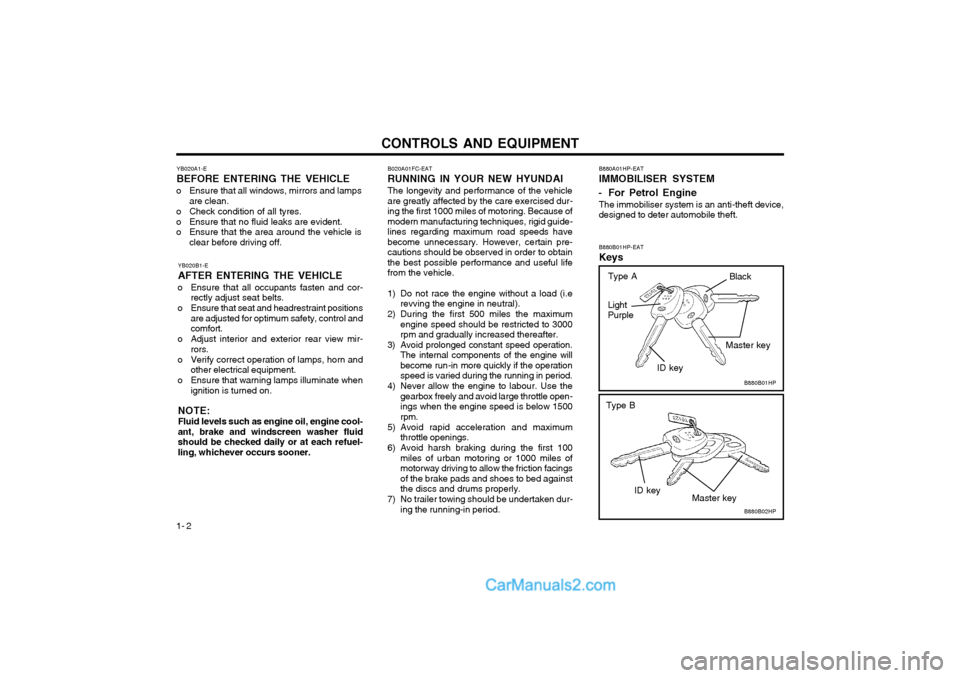
CONTROLS AND EQUIPMENT
1- 2 YB020A1-E BEFORE ENTERING THE VEHICLE
o Ensure that all windows, mirrors and lamps are clean.
o Check condition of all tyres.
o Ensure that no fluid leaks are evident.
o Ensure that the area around the vehicle is clear before driving off.
YB020B1-E AFTER ENTERING THE VEHICLE
o Ensure that all occupants fasten and cor- rectly adjust seat belts.
o Ensure that seat and headrestraint positions are adjusted for optimum safety, control and comfort.
o Adjust interior and exterior rear view mir- rors.
o Verify correct operation of lamps, horn and other electrical equipment.
o Ensure that warning lamps illuminate when ignition is turned on.
NOTE: Fluid levels such as engine oil, engine cool- ant, brake and windscreen washer fluidshould be checked daily or at each refuel-ling, whichever occurs sooner. B020A01FC-EAT RUNNING IN YOUR NEW HYUNDAIThe longevity and performance of the vehicle are greatly affected by the care exercised dur-ing the first 1000 miles of motoring. Because ofmodern manufacturing techniques, rigid guide-lines regarding maximum road speeds havebecome unnecessary. However, certain pre-cautions should be observed in order to obtainthe best possible performance and useful lifefrom the vehicle.
1) Do not race the engine without a load (i.e revving the engine in neutral).
2) During the first 500 miles the maximum engine speed should be restricted to 3000rpm and gradually increased thereafter.
3) Avoid prolonged constant speed operation. The internal components of the engine willbecome run-in more quickly if the operation
speed is varied during the running in period.
4) Never allow the engine to labour. Use the gearbox freely and avoid large throttle open-ings when the engine speed is below 1500rpm.
5) Avoid rapid acceleration and maximum throttle openings.
6) Avoid harsh braking during the first 100 miles of urban motoring or 1000 miles ofmotorway driving to allow the friction facingsof the brake pads and shoes to bed againstthe discs and drums properly.
7) No trailer towing should be undertaken dur- ing the running-in period. B880A01HP-EAT IMMOBILISER SYSTEM
- For Petrol Engine The immobiliser system is an anti-theft device, designed to deter automobile theft. B880B01HP-EAT Keys
B880B01HP
B880B02HP
Light Purple
ID key
ID key Master key
Master key
Type B
Black
Type A
Page 203 of 361
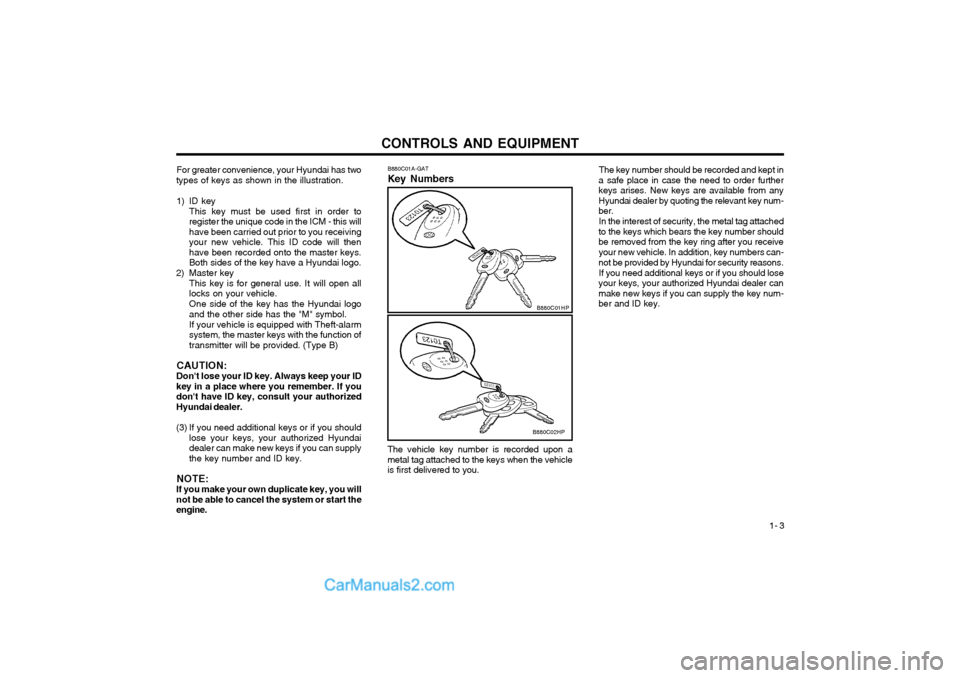
CONTROLS AND EQUIPMENT1- 3
The key number should be recorded and kept in
a safe place in case the need to order further keys arises. New keys are available from anyHyundai dealer by quoting the relevant key num-ber.
In the interest of security, the metal tag attached
to the keys which bears the key number shouldbe removed from the key ring after you receive
your new vehicle. In addition, key numbers can-
not be provided by Hyundai for security reasons.
If you need additional keys or if you should lose
your keys, your authorized Hyundai dealer canmake new keys if you can supply the key num-ber and ID key.
For greater convenience, your Hyundai has two
types of keys as shown in the illustration.
1) ID key This key must be used first in order toregister the unique code in the ICM - this willhave been carried out prior to you receivingyour new vehicle. This ID code will thenhave been recorded onto the master keys.Both sides of the key have a Hyundai logo.
2) Master key This key is for general use. It will open alllocks on your vehicle. One side of the key has the Hyundai logo and the other side has the "M" symbol. If your vehicle is equipped with Theft-alarm system, the master keys with the function oftransmitter will be provided. (Type B)
CAUTION:
Don't lose your ID key. Always keep your IDkey in a place where you remember. If youdon't have ID key, consult your authorizedHyundai dealer.
(3) If you need additional keys or if you should lose your keys, your authorized Hyundai dealer can make new keys if you can supplythe key number and ID key.
NOTE:
If you make your own duplicate key, you willnot be able to cancel the system or start theengine. B880C01A-GAT Key Numbers The vehicle key number is recorded upon a metal tag attached to the keys when the vehicleis first delivered to you.
B880C01HP
B880C02HP
Page 204 of 361
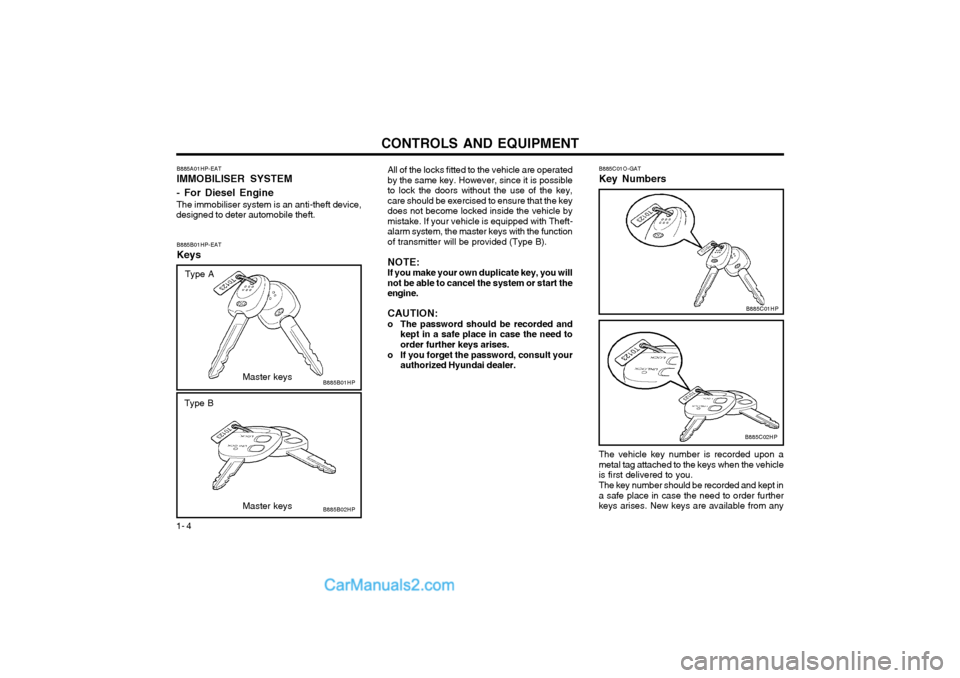
CONTROLS AND EQUIPMENT
1- 4 B885A01HP-EAT IMMOBILISER SYSTEM - For Diesel Engine The immobiliser system is an anti-theft device,
designed to deter automobile theft.
B885B01HP-EATKeys
B885B01HP
All of the locks fitted to the vehicle are operated by the same key. However, since it is possibleto lock the doors without the use of the key,care should be exercised to ensure that the keydoes not become locked inside the vehicle bymistake. If your vehicle is equipped with Theft-alarm system, the master keys with the functionof transmitter will be provided (Type B).
NOTE:If you make your own duplicate key, you willnot be able to cancel the system or start theengine. CAUTION:
o The password should be recorded and kept in a safe place in case the need toorder further keys arises.
o If you forget the password, consult your authorized Hyundai dealer.
Type A
B885B02HP
Type BB885C01O-GAT Key Numbers
B885C01HP
B885C02HP
The vehicle key number is recorded upon a metal tag attached to the keys when the vehicleis first delivered to you. The key number should be recorded and kept in a safe place in case the need to order furtherkeys arises. New keys are available from any
Master keys Master keys
Page 207 of 361
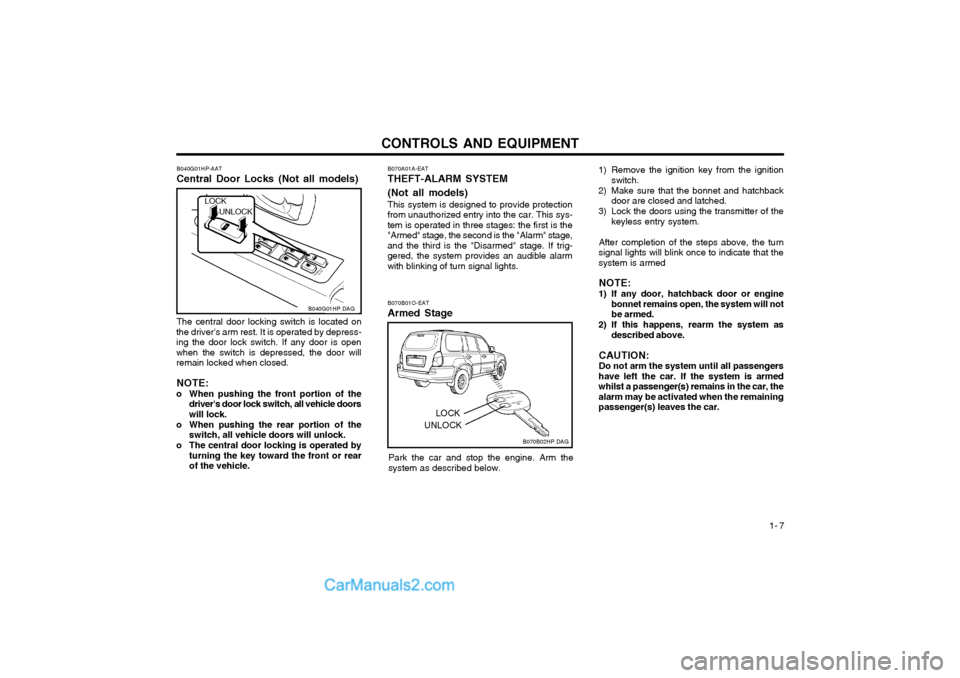
CONTROLS AND EQUIPMENT1- 7
B070A01A-EAT THEFT-ALARM SYSTEM (Not all models) This system is designed to provide protection
from unauthorized entry into the car. This sys- tem is operated in three stages: the first is the"Armed" stage, the second is the "Alarm" stage,and the third is the "Disarmed" stage. If trig-gered, the system provides an audible alarmwith blinking of turn signal lights.
B070B01O-EAT Armed Stage
B070B02HP.DAG
Park the car and stop the engine. Arm the
system as described below.
UNLOCK LOCK
B040G01HP-AAT Central Door Locks (Not all models)
The central door locking switch is located on
the driver's arm rest. It is operated by depress- ing the door lock switch. If any door is openwhen the switch is depressed, the door willremain locked when closed.
NOTE:
o When pushing the front portion of the driver's door lock switch, all vehicle doorswill lock.
o When pushing the rear portion of the switch, all vehicle doors will unlock.
o The central door locking is operated by turning the key toward the front or rearof the vehicle.
B040G01HP.DAG 1) Remove the ignition key from the ignition
switch.
2) Make sure that the bonnet and hatchback door are closed and latched.
3) Lock the doors using the transmitter of the keyless entry system.
After completion of the steps above, the turn
signal lights will blink once to indicate that the system is armed
NOTE:
1) If any door, hatchback door or engine bonnet remains open, the system will notbe armed.
2) If this happens, rearm the system as described above.
CAUTION:Do not arm the system until all passengers
have left the car. If the system is armedwhilst a passenger(s) remains in the car, thealarm may be activated when the remainingpassenger(s) leaves the car.
LOCK
UNLOCK
Page 208 of 361
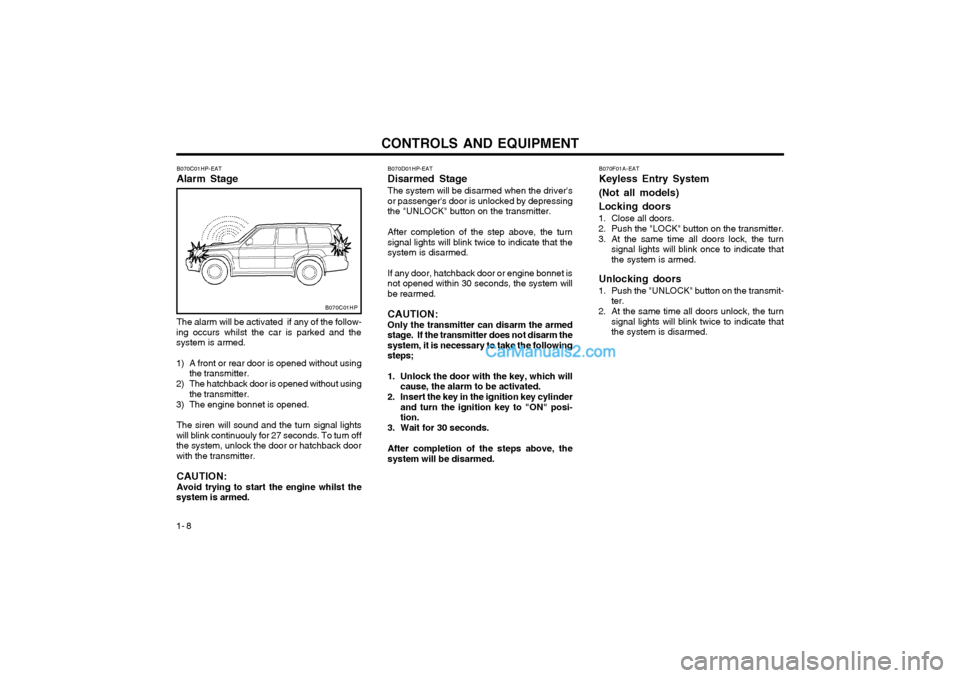
CONTROLS AND EQUIPMENT
1- 8
B070D01HP-EAT Disarmed StageThe system will be disarmed when the driver's or passenger's door is unlocked by depressingthe "UNLOCK" button on the transmitter. After completion of the step above, the turn signal lights will blink twice to indicate that thesystem is disarmed. If any door, hatchback door or engine bonnet is not opened within 30 seconds, the system willbe rearmed. CAUTION: Only the transmitter can disarm the armed stage. If the transmitter does not disarm thesystem, it is necessary to take the followingsteps;
1. Unlock the door with the key, which will cause, the alarm to be activated.
2. Insert the key in the ignition key cylinder and turn the ignition key to "ON" posi- tion.
3. Wait for 30 seconds. After completion of the steps above, the system will be disarmed.
B070C01HP-EAT Alarm Stage
B070F01A-EATKeyless Entry System (Not all models) Locking doors
1. Close all doors.
2. Push the "LOCK" button on the transmitter.
3. At the same time all doors lock, the turn signal lights will blink once to indicate that the system is armed.
Unlocking doors
1. Push the "UNLOCK" button on the transmit- ter.
2. At the same time all doors unlock, the turn signal lights will blink twice to indicate thatthe system is disarmed.
B070C01HP
The alarm will be activated if any of the follow-
ing occurs whilst the car is parked and the system is armed.
1) A front or rear door is opened without using the transmitter.
2) The hatchback door is opened without using the transmitter.
3) The engine bonnet is opened.
The siren will sound and the turn signal lights
will blink continuouly for 27 seconds. To turn off the system, unlock the door or hatchback doorwith the transmitter.
CAUTION: Avoid trying to start the engine whilst the
system is armed.
Page 228 of 361
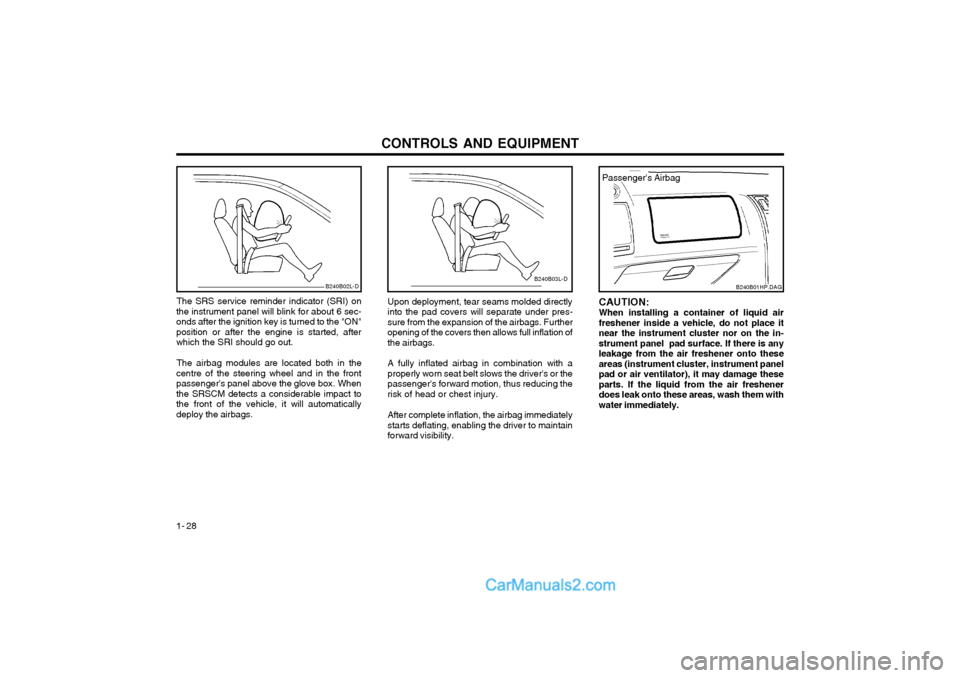
CONTROLS AND EQUIPMENT
1- 28
Upon deployment, tear seams molded directly into the pad covers will separate under pres-sure from the expansion of the airbags. Furtheropening of the covers then allows full inflation ofthe airbags. A fully inflated airbag in combination with a properly worn seat belt slows the driver's or thepassenger's forward motion, thus reducing the risk of head or chest injury. After complete inflation, the airbag immediately starts deflating, enabling the driver to maintainforward visibility.
B240B02L-D
The SRS service reminder indicator (SRI) on
the instrument panel will blink for about 6 sec- onds after the ignition key is turned to the "ON"position or after the engine is started, afterwhich the SRI should go out.
The airbag modules are located both in the
centre of the steering wheel and in the frontpassenger's panel above the glove box. Whenthe SRSCM detects a considerable impact tothe front of the vehicle, it will automaticallydeploy the airbags.B240B03L-D
CAUTION: When installing a container of liquid airfreshener inside a vehicle, do not place itnear the instrument cluster nor on the in-strument panel pad surface. If there is anyleakage from the air freshener onto theseareas (instrument cluster, instrument panelpad or air ventilator), it may damage theseparts. If the liquid from the air freshenerdoes leak onto these areas, wash them withwater immediately.
B240B01HP.DAG
Passenger's Airbag
Page 229 of 361
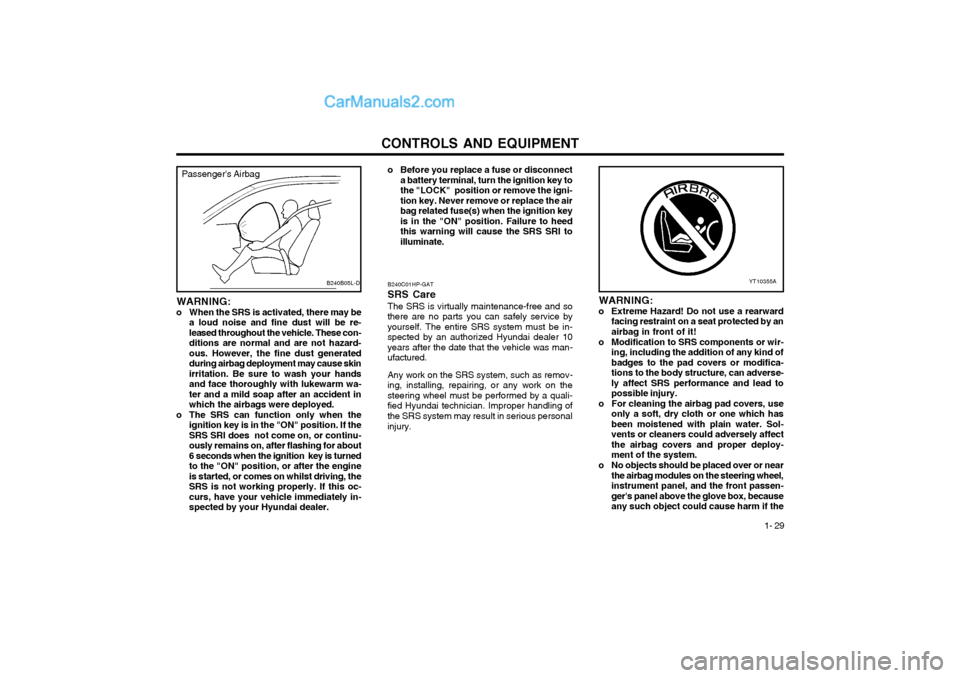
CONTROLS AND EQUIPMENT1- 29
B240C01HP-GAT SRS CareThe SRS is virtually maintenance-free and so
there are no parts you can safely service by yourself. The entire SRS system must be in-
spected by an authorized Hyundai dealer 10years after the date that the vehicle was man-ufactured.
Any work on the SRS system, such as remov-
ing, installing, repairing, or any work on thesteering wheel must be performed by a quali-
fied Hyundai technician. Improper handling ofthe SRS system may result in serious personal
injury. WARNING:
o Extreme Hazard! Do not use a rearward facing restraint on a seat protected by anairbag in front of it!
o Modification to SRS components or wir- ing, including the addition of any kind ofbadges to the pad covers or modifica-
tions to the body structure, can adverse-ly affect SRS performance and lead topossible injury.
o For cleaning the airbag pad covers, use only a soft, dry cloth or one which hasbeen moistened with plain water. Sol-
vents or cleaners could adversely affectthe airbag covers and proper deploy-ment of the system.
o No objects should be placed over or near the airbag modules on the steering wheel,instrument panel, and the front passen-
ger's panel above the glove box, becauseany such object could cause harm if the
YT10355A
Passenger's Airbag
B240B05L-D
WARNING:
o When the SRS is activated, there may be a loud noise and fine dust will be re- leased throughout the vehicle. These con-ditions are normal and are not hazard-ous. However, the fine dust generatedduring airbag deployment may cause skinirritation. Be sure to wash your handsand face thoroughly with lukewarm wa-ter and a mild soap after an accident inwhich the airbags were deployed.
o The SRS can function only when the ignition key is in the "ON" position. If theSRS SRI does not come on, or continu-ously remains on, after flashing for about6 seconds when the ignition key is turnedto the "ON" position, or after the engineis started, or comes on whilst driving, theSRS is not working properly. If this oc-curs, have your vehicle immediately in-spected by your Hyundai dealer. o Before you replace a fuse or disconnect
a battery terminal, turn the ignition key tothe "LOCK" position or remove the igni-tion key. Never remove or replace the airbag related fuse(s) when the ignition keyis in the "ON" position. Failure to heedthis warning will cause the SRS SRI toilluminate.
Page 230 of 361
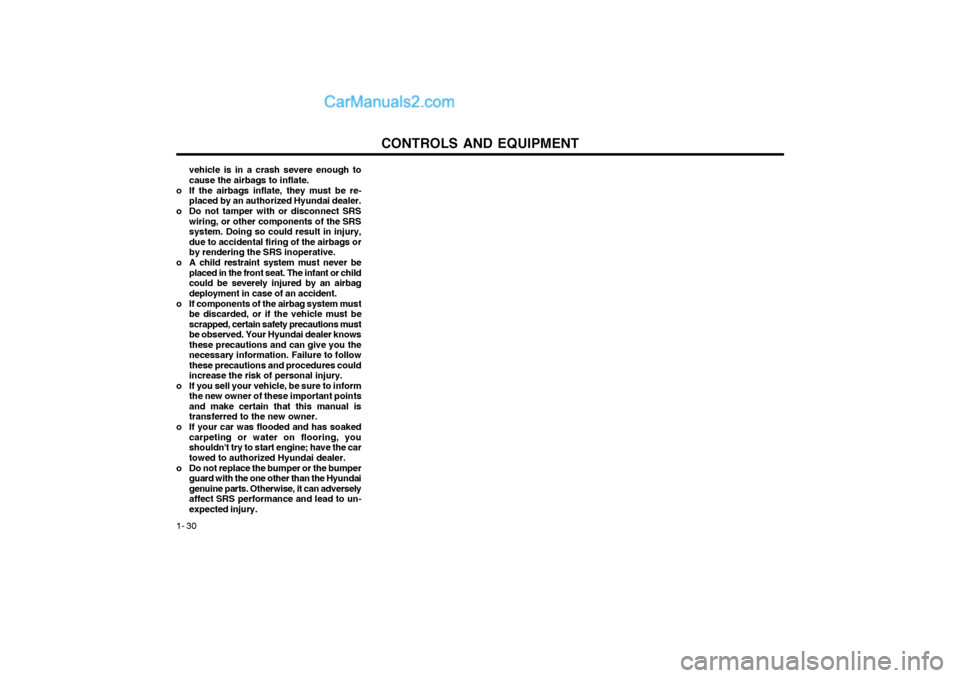
CONTROLS AND EQUIPMENT
1- 30 vehicle is in a crash severe enough to cause the airbags to inflate.
o If the airbags inflate, they must be re- placed by an authorized Hyundai dealer.
o Do not tamper with or disconnect SRS wiring, or other components of the SRSsystem. Doing so could result in injury,due to accidental firing of the airbags orby rendering the SRS inoperative.
o A child restraint system must never be placed in the front seat. The infant or childcould be severely injured by an airbagdeployment in case of an accident.
o If components of the airbag system must be discarded, or if the vehicle must bescrapped, certain safety precautions must
be observed. Your Hyundai dealer knowsthese precautions and can give you thenecessary information. Failure to followthese precautions and procedures couldincrease the risk of personal injury.
o If you sell your vehicle, be sure to inform the new owner of these important pointsand make certain that this manual istransferred to the new owner.
o If your car was flooded and has soaked carpeting or water on flooring, youshouldn't try to start engine; have the cartowed to authorized Hyundai dealer.
o Do not replace the bumper or the bumper guard with the one other than the Hyundaigenuine parts. Otherwise, it can adverselyaffect SRS performance and lead to un-expected injury.
Page 232 of 361
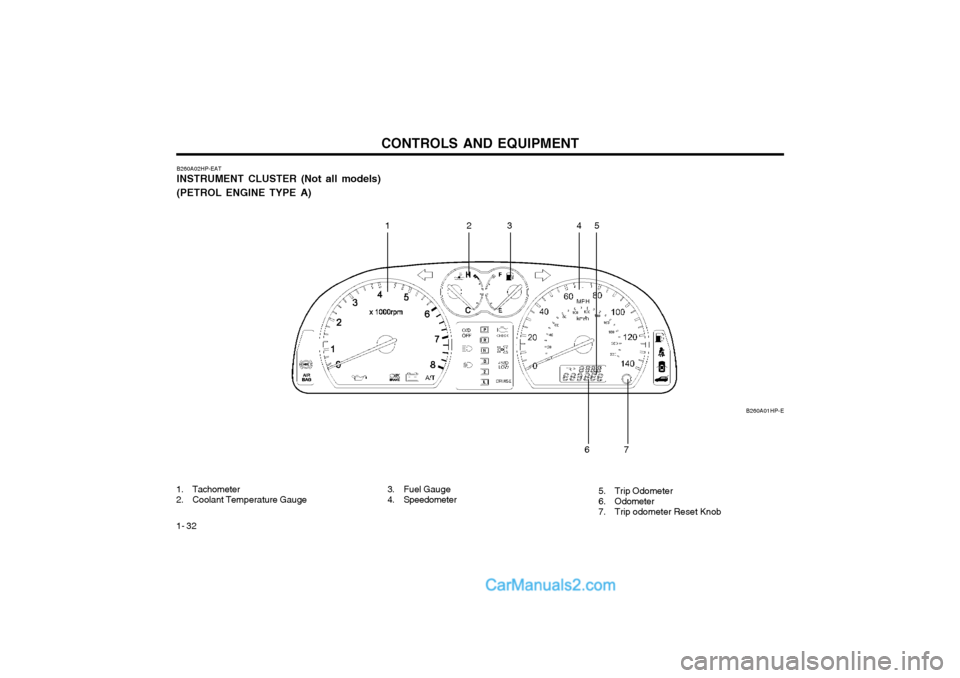
CONTROLS AND EQUIPMENT
1- 32
B260A01HP-E
B260A02HP-EAT INSTRUMENT CLUSTER (Not all models) (PETROL ENGINE TYPE A)
1. Tachometer
2. Coolant Temperature Gauge
12 345
7
6
3. Fuel Gauge
4. Speedometer 5. Trip Odometer
6. Odometer
7. Trip odometer Reset Knob